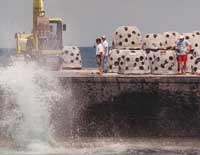

Story last updated at 12:29 a.m. on Tuesday, June 6, 2000
It might not sound exciting, but the onlookers knew something
about the hollow concrete balls splashing into the ocean: In a few
months, those drab chunks will become colorful homes for throngs of
fish and give coral and algae a new place to grow.
More than 500 of the reef balls, some of which were built by
marine science students at Mandarin High School, were deployed
yesterday at a location called Bunny's Web. The individual balls
will create a reef where sea creatures can thrive about 60 feet
underwater, said Mandarin teacher Alex Waters, who helped his
students construct about 15 balls of varying sizes.
"We're helping the environment," 17-year-old Mandarin student
Matt Brown said. "I mean, if we make more reefs, more fish will
live."
Brown and Waters joined about two dozen others to watch the balls
dropped into the ocean yesterday. The $85,000 project, called the
Charles H. Kirbo Memorial Reef, was funded through the Atlanta-based
Reef Ball Foundation, which is led by Kirbo's daughter.
"He always fished in this area," Kathy Kirbo said of her father,
who was an Atlanta lawyer and served as an adviser to President
Jimmy Carter. "He was a great fisherman and conservationist."
The artificial reef can be used for scuba diving, fishing and
marine education.
Reef Ball Development Group Ltd. of Bradenton provided the
fiberglass molds to make the reef balls. Since 1992, the company has
deployed more than 100,000 balls around the world, president Todd
Barber said.
Artificial reefs have been used before in the form of junk or old
ships in order to lure fish to a specific spot, but reef balls also
provide places for young fish to grow, Barber said.
And it's becoming big business: Georgia-based company Eternal
Reefs mixes concrete for the balls with cremated remains to create a
"living memorial," company president Don Brawley said.
Each ball, Barber said, supports the production of 400 pounds of
fish per year, and the balls are built to last at least 500 years.
About 10 years after the balls are deployed, he said, coral will
have covered them to mimic a natural coral reef. The Reef Ball
Foundation requires that its projects also be used for education, so
Waters' diving-certified students will be able to scuba dive to the
site to monitor its growth.
"We try to make all of our projects community events," Barber
said.
St. Augustine students also helped create some of the reef balls,
which can be as heavy as the 4,000-pound "Ultra Balls." It would
take 1,000 years for nature to generate a coral reef the size of a
4-by-6-foot ultra ball, Barber said.
"We're jump-starting the ecosystem by decades, by eons," he said.
This site, and all its content, © The Florida Times-Union |
